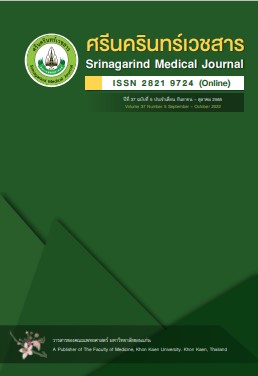ลักษณะทางพยาธิวิทยาคลินิก อัตราการรอดชีพและปัจจัยพยากรณ์การรอดชีพของผู้ป่วยโรคมะเร็งกระเพาะอาหาร
The Clinicopathologic Features, Survival Rate and Prognostic Factors on Survival of Patients with Stomach Cancer
Abstract
หลักการและวัตถุประสงค์: ในแต่ละปีทั่วโลกมีผู้ป่วยและเสียชีวิตด้วยโรคมะเร็งกระเพาะอาหารเป็นจำนวนมาก วัตถุประสงค์เพื่อศึกษาข้อมูลลักษณะทางพยาธิวิทยาคลินิก อัตราการรอดชีพ และปัจจัยพยากรณ์โรคของผู้ป่วยโรคมะเร็งกระเพาะอาหาร
วิธีการศึกษา: เป็นการศึกษาแบบ retrospective cohort study โดยเก็บข้อมูลประวัติการรักษาจากเวชระเบียนของผู้ป่วยโรคมะเร็งกระเพาะอาหารที่เข้ารับการรักษาที่โรงพยาบาลร้อยเอ็ดระหว่าง 1 มกราคม พ.ศ. 2558 ถึง 31 ธันวาคม พ.ศ. 2563 และติดตามไปจนกระทั่งทราบสถานะสุดท้ายของการมีชีวิตหรือจนถึงวันที่ 30 เมษายน 2565 วิเคราะห์ข้อมูลใช้ สถิติเชิงพรรณนา การวิเคราะห์โอกาสรอดชีพด้วยแคปลานและไมย์เออร์ สถิติ Log rank test และ Cox proportional hazard model โดยกำหนดระดับนัยสำคัญที่ p<0.05
ผลการศึกษา: ผู้ป่วยจำนวน 354 ราย ส่วนใหญ่เป็นเพศชายร้อยละ 61.58 มีอายุเฉลี่ย 59.76 ± 13.35 ปี เป็นมะเร็ง Stage IV ร้อยละ 53.95 ติดเชื้อ H. pylori ร้อยละ 62.15 มีระยะติดตาม 4,898 คน-เดือน เมื่อสิ้นสุดการศึกษามีผู้ป่วยเสียชีวิตจำนวน 308 รายคิดเป็นอัตราอุบัติการณ์ 6.28 ต่อ 100 ราย/เดือน ค่ามัธยฐานระยะเวลาการรอดชีพ 5.30 เดือน อัตรารอดชีพ 1, 3 และ 5 ปี ร้อยละ 31.92, 13.29 และ 10.85 ตามลำดับ ผลการวิเคราะห์พบว่าปัจจัยพยากรณ์การรอดชีพของผู้ป่วยได้แก่ มะเร็ง stage IV (Adj HR.: 3.22; 95% CI; 1.57-6.60), direct extension (Adj HR.: 2.43; 95% CI; 1.43-4.12), การแพร่กระจายของมะเร็งไปยัง lung / pleura (Adj.HR: 2.67; 95% CI; 1.17-6.08), peritoneum (Adj.HR: 2.04; 95% CI; 1.03-4.04), bone (Adj HR.: 3.16; 95% CI; 1.99-10.06), brain (Adj HR.: 12.73; 95% CI; 1.69-95.55), lymph node (Adj HR.: 1.92; 95% CI; 1.04-3.54), multiple sites (Adj HR.: 2.11; 95% CI; 1.54-2.88), ติดเชื้อ H. pylori (Adj.HR: 3.63 (2.79-4.74) และ supportive treatment (Adj.HR: 2.45; 95% CI; 1.93-3.10)
สรุป: การศึกษาครั้งนี้พบว่าโอกาสรอดชีพของผู้ป่วยมะเร็งกระเพาะอาหารรอดชีพมีความสัมพันธ์กับการเป็นมะเร็งระยะรุนแรง การติดเชื้อ H. pylori และการแพร่กระจายของมะเร็งไปยังอวัยวะอื่นๆ และ supportive treatment การค้นหาและการวินิจฉัยโรคตั้งแต่เนิ่นๆ การเข้าถึงวิธีการรักษาที่มีประสิทธิภาพในเวลาที่เหมาะสมเป็นปัจจัยสำคัญในการเพิ่มโอกาสรอดชีพของผู้ป่วยให้สูงขึ้น
คำสำคัญ: มะเร็งกระเพาะอาหาร, อัตรารอดชีพ, ปัจจัยพยากรณ์โรค
Background and Objectives: Every year, a large number of people worldwide suffer from gastric cancer and die from stomach cancer. The objective of the study was to explore the clinicopathological characteristics, survival rate, and prognostic factors of stomach cancer patients.
Methods: These was a retrospective cohort study, all data were collected from medical record of patients with stomach cancer at Roi Et hospitals between January 1, 2015 and December 31, 2020, and were follow-up for the final vital status or end of the study period on April 30, 2022. Data analysis used descriptive statistics, The Kaplan-Meier survival curve , Log rank test, and Cox proportional hazard model. The statistical significance was set at p<0.05.
Results: Of 354 patients, most of them were male 61.58%, mean age of 59.76± 13.35 years , cancer Stage IV 53.95%, and H. pylori infection 62.15%. The total follow-up times were 4,898 person-months. Of 308 cases died at the end of the study with an incidence rate of 6.28 per 100 person-months. The overall median survival time was 5.30 months. The 1, 3, and 5 years survival were 31.92%, 13.29%, and 10.85% respectively. The prognosis factors on survival of patient were cancer stage IV (Adj HR.: 3.22; 95% CI; 1.57-6.60), direct extension (Adj HR.: 2.43; 95% CI; 1.43-4.12), cancer metastasis to lung / pleura (Adj HR.: 2.67; 95% CI; 1.17-6.08), peritoneum (Adj HR.: 2.04; 95% CI; 1.03-4.04), bone (Adj HR.: 3.16; 95% CI; 1.99-10.06), brain (Adj HR.: 12.73; 95% CI; 1.69-95.55), lymph node (Adj HR.: 1.92; 95% CI; 1.04-3.54), multiple sites (Adj.HR: 2.11; 95% CI; 1.54-2.88), H. pylori infection (Adj.HR: 3.63 (2.79-4.74), and supportive treatment (Adj HR.: 2.45; 95% CI; 1.93-3.10)
Conclusion: This study revealed that survival of stomach cancer patient associated with advanced stage of diseases, H. pylori infection, metastasis of the cancer to other organs and supportive treatment. Early detection and diagnosis, and accessing effective treatments at the right time were essential factors that increased survival of patients.
Keywords: stomach cancer, survival rate, prognostic factors


